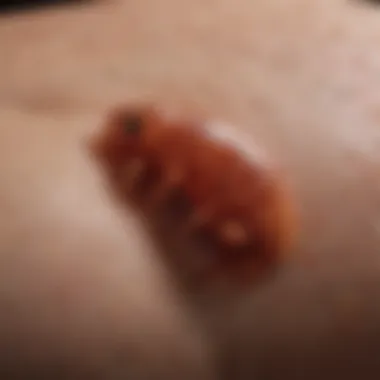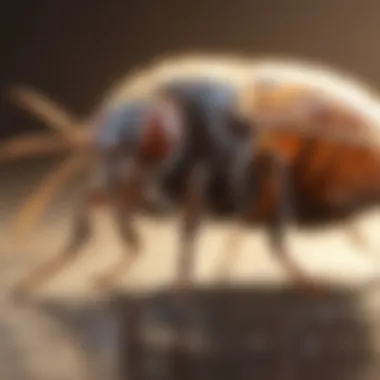Understanding Flea Bites on Humans: Identification and Management


Intro
Flea bites present a common but often overlooked issue for many people. Understanding how to identify and manage these bites is crucial for maintaining comfort and preventing further infestation. This article provides an in-depth look at fleas, their characteristics, and their implications for human health. By recognizing the signs of flea bites and knowing how to address them, readers can take proactive steps toward better health.
Animal Overview
Common Names
Fleas belong to a group of small, flightless insects that are notorious for their ability to infest homes and pets. Some of the most recognized common names for fleas include the cat flea, dog flea, and human flea. Each type has unique behaviors that impact how they interact with humans and animals.
Scientific Classification
Fleas are classified as members of the order Siphonaptera. This diverse group includes approximately 2,500 species, with the most prominent being Ctenocephalides felis (the cat flea) and Ctenocephalides canis (the dog flea). Understanding their classification helps in identifying the specific species that may be causing bites or infestations.
Geographic Range
Flea species are widespread across the globe. They thrive in both urban and rural environments, primarily in areas with their hosts. Regions with higher populations of cats and dogs often experience significant flea infestations. This reality increases the importance of awareness and management practices in various geographical contexts.
Behavior and Social Structure
Social Behavior
Fleas are generally solitary creatures but congregate in areas where they can find hosts. They are highly mobile, moving quickly between hosts and environments. Their ability to jump great distances relative to their size allows them to navigate efficiently in search of food and breeding sites.
Communication
Fleas do not communicate in ways typical of other animals. Instead, their interactions are largely driven by instinct and pheromones. These chemical signals help fleas locate suitable mates and recognize when a host is nearby.
Mating and Reproduction
Fleas reproduce quickly. A single female can lay hundreds of eggs in her lifetime. These eggs fall to the ground, making control efforts challenging. Understanding their reproductive habits is essential for effective management in homes and around pets.
Habitat and Ecosystem
Natural Habitat
Fleas can be found in various environments. They prefer areas with sufficient warmth and humidity. Their preferred habitats include grass, soil, and the fur of animals. When considering flea bites, it is essential to know where these pests thrive.
Food Sources and Diet
Fleas feed primarily on the blood of mammals and birds. When they bite, they leave a small puncture wound, causing irritation and discomfort. This feeding behavior is a significant reason fleas are considered pests.
Role in Ecosystem
While fleas are often seen as nuisances, they do play a role in the ecosystem. They serve as food for various predators and are part of the complex food web. However, their impact on human health, particularly through their bites, cannot be understated.
Fleas are a common source of discomfort for pets and humans alike. Identifying their bites promptly can lead to more effective management strategies.
By comprehending the characteristics and behaviors of fleas, individuals can take informed steps to prevent and treat flea bites. This awareness underscores the relevance of understanding flea biology, ultimately leading to better health outcomes.
Prologue to Flea Bites
Flea bites are more than just an annoyance; they serve as a gateway to understanding the health implications associated with these parasitic insects. This section offers a thorough introduction to flea bites, emphasizing their significance in the broader context of human health and well-being. Knowing how to recognize and manage flea bites can greatly reduce discomfort and prevent potential complications.
Fleas feed on the blood of their hosts, and humans can easily become accidental targets. They are commonly found in environments where pets reside, but they can also be introduced into homes through other means. Understanding why these bites occur and how to identify them is crucial for effective intervention.
Understanding Fleas as Parasitic Insects
Fleas are small, wingless insects belonging to the order Siphonaptera. They are considered ectoparasites, as they live on the outside of their hosts and subsist by biting, a behavior that leads to irritation and discomfort. Fleas are adaptable creatures; they thrive in varied environments from urban apartments to rural settings.


The lifecycle of a flea includes several stages: egg, larva, pupa, and adult. Adult fleas are the most known stage, characterized by their ability to jump significant distances, often more than 150 times their body length. Their bodies are flattened laterally, making it easier for them to navigate through fur or feathers. Understanding these attributes provides insights into how easily they can transmit from animals to humans.
Fleas are not just a nuisance. Their bites can lead to health issues such as allergic reactions, secondary infections, and even the transmission of diseases like typhus and plague. It is essential not only to recognize flea bites but also to comprehend the biology of fleas, as doing so can enhance preventive strategies and inform treatment options.
By acknowledging the significance of flea bites and the nature of the pests that cause them, we can better prepare to deal with potential infestations effectively, ensuring both comfort and health.
Visual Characteristics of Flea Bites on Humans
Understanding the visual characteristics of flea bites is crucial for accurate identification and prompt management. By being able to recognize these specific features, individuals can differentiate flea bites from other insect bites or skin conditions. This knowledge can prevent unnecessary anxiety or poor treatment choices. Moreover, awareness of visual characteristics can aid in identifying the presence of fleas in one's living environment, prompting necessary actions to eliminate these pests.
Color and Shape of Flea Bite Marks
Flea bites usually exhibit a distinct appearance. Typically, they are small red or reddish-brown spots that can be easily overlooked at first glance. The shape of the bites is often round and raised, resembling a tiny pimple. Each mark may have a darker spot in the center, often referred to as a puncture mark, left by the flea’s mouthparts.
Itchy welts may also develop around the bites, adding to the discomfort felt by individuals. These bites generally cluster together in groups of two to three. This pattern can be an indicator of flea infestation, as fleas tend to bite multiple times in succession.
Common Locations on the Body
Flea bites tend to favor specific areas of the body. The most commonly affected regions include:
- Ankles
- Legs
- Waist
- Armpits
- Inner elbows
These areas are often more exposed or less protected, making them prime targets. Fleas can jump quite well and may bite humans while they are standing or sitting near infested animals or surfaces.
It is essential to check these areas if there is any suspicion of flea bites, as early identification can reduce the chance of further irritation or complications.
Comparison with Other Insect Bites
Flea bites can often be confused with bites from other insects, like mosquitoes or bedbugs. However, there are several distinctive differences:
- Bite Patterns: Flea bites usually appear in clusters or lines, whereas mosquito bites are typically solitary.
- Size and Appearance: Flea bites are smaller and have a more pronounced center puncture mark compared to other insect bites.
- Location Preference: Unlike fleas, mosquitoes primarily prefer to bite exposed skin, while fleas often bite lower on the body, such as ankles and legs.
Understanding these differences is vital for effective diagnosis and treatment. Misidentification can lead to improper treatment and continued discomfort.
Recognizing these characteristics can not only provide relief but also aid in taking preventive measures against further infestations.
Common Symptoms Associated with Flea Bites
Understanding the symptoms associated with flea bites is crucial for effective identification, management, and prevention. Many individuals may not recognize that they are dealing with flea bites, mistaking them for other insect bites or skin irritations. Recognizing the symptoms early can help in alleviating discomfort and preventing exacerbation. This section will explore the common symptoms associated with flea bites, focusing on the reactions that humans may experience following exposure to fleas.
Itching and Irritation
One of the primary symptoms of flea bites is itching. This sensation is created by the saliva injected by fleas during feeding. The body's immune response interprets the saliva as a foreign substance, leading to histamine release, causing intense itchiness. This can lead to a cycle where the more the affected person scratches, the more irritated the skin becomes.
Itching can vary from mild to severe, depending on individual sensitivity and how long the flea has been feeding. In some cases, this may escalate to a constant urge to scratch, which can be disruptive to daily activities and sleep.
Key points to remember:
- Severity varies among individuals.
- Scratching can exacerbate the irritation and lead to potential skin damage.
Swelling and Inflammation
Flea bites can also cause noticeable swelling and inflammation around the affected area. The extent of this reaction can depend on the individual's skin type and immune response.
Typically, a bite will appear as a small red bump; however, in some cases, the swelling can increase, creating an uncomfortable lump. The area may feel warm to the touch and tender, signaling an inflammation response.
In severe cases, swelling can extend beyond the immediate bite site, resembling larger welts that may prompt further concern. Such reactions warrant careful observation, especially if the area continues to grow or becomes increasingly painful.
Considerations include:


- Monitor for changes in swelling.
- Inflamed areas may require topical treatments to reduce discomfort.
Potential Allergic Reactions
In some instances, individuals may develop allergic reactions to flea bites. This response can manifest as hives or extensive rashes that can be distressing. Allergic reactions often follow a unique timeline, appearing after initial exposure to flea saliva.
For those with existing sensitivities, even a single bite can trigger an exaggerated immune response, leading to symptoms that go beyond mere itching or swelling. Such reactions can be systemic, involving more than just localized symptoms, and may require immediate medical attention.
It is essential to recognize the signs of a potential allergic reaction, which can include:
- Widespread skin rashes.
- Difficulty breathing or swallowing (in severe cases).
- Swelling in areas other than the bite.
Overall, identifying these common symptoms associated with flea bites is a crucial step in effective management. Immediate recognition and appropriate action can lead to better recovery outcomes and minimize discomfort.
Diagnosis of Flea Bites
The diagnosis of flea bites is a crucial aspect of managing the discomfort and health concerns associated with these infestations. Understanding how to effectively identify and differentiate flea bites from other insect bites or skin conditions can lead to prompt and appropriate treatment. Misdiagnosis may result in prolonged exposure to fleas and potential complications, such as infections. Therefore, being informed about diagnosis empowers individuals to act decisively and seek suitable remedies, ultimately promoting better health outcomes.
Self-Diagnosis Techniques
Identifying flea bites can often be achieved through careful self-assessment. Here are several techniques to assist in the self-diagnosis process:
- Observe the Bite Patterns: Flea bites typically appear in clusters or rows, which can help differentiate them from other insect bites. Commonly affected areas include the ankles, legs, and sometimes the waist.
- Examine Symptoms: Common symptoms associated with flea bites include itching, redness, and swelling. Documenting how your skin reacts to potential bites can aid in making a determination.
- Assess Exposure History: Consider your recent interactions with pets or exposure to environments where fleas are common, such as gardens or areas with animals. This information can clarify if flea bites are likely.
- Use a Magnifying Glass: If unsure, use a magnifying glass to examine the bite closely. Flea bites may present as small red bumps with a defined center.
By following these techniques, individuals can gain insight into whether the bites they are experiencing are likely from fleas.
Role of Healthcare Professionals
Consulting healthcare professionals is important, especially in cases where self-diagnosis is uncertain or when symptoms worsen. Professionals can offer valuable assistance in the diagnosis and management of flea bites. Here are some roles they serve:
- Diagnosis Confirmation: Healthcare providers can confirm the presence of flea bites through examination and medical history. They may also perform tests if there are signs of infection or allergic reaction.
- Guidance on Treatment Options: Professionals can recommend appropriate treatment strategies, which are essential for alleviating symptoms and promoting healing.
- Preventive Advice: They can offer guidance on preventive measures to avoid future infestations, which is crucial for maintaining personal and pet health.
- Monitoring for Complications: In severe cases, healthcare professionals can monitor for secondary infections or complications that may arise from flea bites.
Having access to medical expertise can expedite recovery and ensure a comprehensive approach to managing flea bites.
Treatment Options for Flea Bites
Flea bites can be not only uncomfortable but also lead to more serious health issues if not properly managed. Understanding the best treatment options available is crucial. It aids in alleviating the symptoms like itching and swelling and reduces the risk of secondary infections. Immediate management options help ensure comfort and faster recovery, as well as prevent the further spread of these annoying pests.
Topical Treatments and Remedies
Topical treatments are the first line of defense against flea bites. These remedies primarily focus on relieving symptoms such as itching and swelling. They are usually easy to apply and can provide quick relief. Common topical treatments include:
- Hydrocortisone cream: This reduces inflammation and itching. It is often recommended for short-term use.
- Antihistamine creams: Products containing diphenhydramine can help soothe the skin and lessen itching.
- Calamine lotion: This is useful for its soothing properties, helping to cool down irritated skin.
- Aloe vera gel: Known for its natural healing properties, it can be applied to the affected area for relief from irritation.
When using topical treatments, it is essential to follow the instructions on the package. Keep in mind that if symptoms persist after a few days of treatment, consulting a healthcare professional is advisable.
Oral Medications for Severe Cases
In some instances, flea bites can lead to severe reactions or discomfort that topical treatments cannot sufficiently address. For these cases, oral medications may be necessary. These include:
- Antihistamines: Oral antihistamines such as cetirizine or loratadine can provide relief from intense itching and swelling.
- Corticosteroids: In cases of significant inflammation, doctors might prescribe oral steroids. These should be used under medical supervision due to potential side effects.
- Pain relievers: Over-the-counter pain relievers like ibuprofen or acetaminophen can be beneficial for managing pain associated with severe reactions.
Always consult with a healthcare provider before starting any medication, especially if you have pre-existing health conditions or are pregnant.
Home Remedies and Natural Solutions
Some people prefer home remedies to address flea bites. These alternatives can be effective while also being gentle on the skin. Common home remedies include:
- Oatmeal baths: Adding colloidal oatmeal to a warm bath can help soothe itchy skin and reduce inflammation.
- Baking soda paste: Mixing baking soda with a little water to form a paste can be applied to the bite area to alleviate itching.
- Essential oils: Oils like lavender and tea tree have anti-inflammatory and antimicrobial properties. Diluting them in a carrier oil can offer relief when applied to the bites. However, it is crucial to test for skin sensitivity first.


Natural solutions may take longer to show results, but they can be safe where other solutions may not be wanted. Always do thorough research and take care with their usage, especially on children or those with sensitive skin.
Preventive Measures Against Flea Bites
Preventing flea bites is crucial not just for comfort but also for overall health. Flea infestations can lead to various complications. If they are not controlled, they may result in significant discomfort and even serious health issues. In this section, we will review practical measures that can be taken to minimize the risk of flea bites.
Home Regular Cleaning Strategies
Cleaning the home regularly plays a vital role in reducing flea populations. Here are some effective cleaning strategies:
- Vacuuming: Regular vacuuming of carpets, rugs, and upholstery helps to remove flea eggs and larvae. It is essential to dispose of the vacuum bag or empty the canister immediately, as fleas can survive inside.
- Washing Bedding: All bedding, including pet bedding, should be washed in hot water weekly. This eliminates any fleas or eggs that may be hiding in the fabric.
- Decluttering: Keeping the home free of clutter provides fewer hiding spots for fleas. It also allows for more effective cleaning.
- Scheduled Deep Cleaning: On a quarterly basis, consider deep cleanng carpets and upholstery with a steam cleaner. This work can kill fleas at all life stages.
Maintaining Pet Health
Maintaining the health of pets is essential for flea prevention. Here are key points to consider:
- Regular Vet Check-Ups: Routine veterinary visits are important to check for any signs of fleas. Veterinarians can also provide preventive treatments that are suitable for your pet’s specific needs.
- Flea Preventative Treatments: Utilizing products like Frontline or Advantage can significantly reduce the chances of infestation. These treatments work effectively to kill fleas before they bite.
- Daily Grooming: Regular grooming sessions help to inspect fur closely for fleas or flea dirt. It allows pet owners to catch infestations early, leading to timely treatment.
Using Insect Repellent Products
Insect repellent products can serve as a barrier against fleas. Different options are available:
- Topical Treatments: Products applied directly to the skin can be effective. These treatments need to be reapplied regularly, according to the product guidelines.
- Sprays and Powders: Flea sprays and powders can be utilized on carpets and pet bedding. It’s crucial to select products designed for indoor use to avoid damaging home surfaces.
- Natural Repellents: Natural options, such as lemon or eucalyptus oil, can also deter fleas. However, it is essential to research and ensure these are safe for pets and humans before use.
Regular preventive measures save time and discomfort. It’s easy to be proactive in managing fleas rather than waiting for a reaction.
By implementing these preventive measures, individuals can protect themselves and their pets from fleas. The key is consistency and being vigilant in every aspect of home and pet care.
Long-term Impacts of Flea Infestations
Flea infestations can lead to various long-term health concerns. Understanding these impacts is essential, not only for immediate relief but also for future prevention and overall wellbeing. Fleas are more than just nuisances; they can pose serious health risks that extend beyond the itchy bites they cause. This section will explore significant health implications, potential complications, and the importance of addressing flea infestation promptly.
Health Risks Associated with Fleas
Fleas can transmit several diseases to humans and pets alike. The most notable health risks include:
- Bartonellosis: This bacterial infection, transmitted through flea bites or scratches on cats, can cause fatigue and fever.
- Rickettsiosis: A disease caused by Rickettsia bacteria, which fleas may transmit, leading to severe symptoms including fever and rash.
- Tapeworms: Fleas can host tapeworm larvae. Infected pets can pass these tapeworms through feces, potentially leading to human ingestion if proper hygiene is not followed.
While not every flea bite results in disease transmission, the risk is present. Individuals with compromised immune systems, such as the elderly or those with existing health conditions, may be at a higher risk for severe reactions. Therefore, managing flea populations effectively is crucial.
Potential for Secondary Infections
Flea bites can cause intense itching, leading to scratching and skin irritation. This behavior significantly increases the risk of secondary infections. When the skin’s integrity is compromised due to scratching, bacteria can easily enter the body, resulting in potential issues like:
- Cellulitis: This bacterial skin infection can spread rapidly and may require antibiotic treatment.
- Abscesses: Accumulation of pus may occur if bacteria multiply beneath the skin.
To mitigate these risks, it is essential to keep affected areas clean and consider appropriate topical treatments. Recognizing the signs of secondary infections, such as increased redness, swelling, or pus, is vital for prompt treatment.
Flea infestations might seem manageable, but their long-term impacts can have serious implications on human health. Understanding the health risks and potential for secondary infections helps in creating effective management strategies. From maintaining strict hygiene practices to employing targeted flea control measures, individuals can significantly reduce the likelihood of encountering these challenges. The sooner flea issues are addressed, the better the overall health and comfort for everyone involved.
Culmination
Flea bites are a significant issue for many people, especially those with pets. Understanding the essentials of flea bites, including their identification and management, is crucial for both comfort and health. This article aims to summarize key information on this topic.
Flea bites, while often considered a minor nuisance, can lead to various health concerns if not managed properly. Recognizing the visual characteristics and symptoms associated with these bites is the first step in effective management.
The article discussed the common locations where flea bites occur, particularly the ankles and legs. This is important since identifying these areas can assist in quickly addressing any outbreaks.
Moreover, symptoms such as itching and inflammation can have significant ramifications if left untreated. Some people may even experience allergic reactions, making it essential to act promptly. Appropriate treatment options include topical ointments, oral medications, and even home remedies, offering a range of choices for individuals.
Preventive measures are also a focal point. Regular cleaning of homes, maintaining pet health, and using insect repellent are strategies that can drastically reduce the risk of flea infestations.
Summary of Key Points
- Flea bites primarily occur on the ankles and legs.
- Symptoms include itching, swelling, and potential allergic reactions.
- Treatment options range from over-the-counter ointments to oral medications.
- Preventive measures include home cleaning and pet health management.
Understanding these points is vital for anyone looking to manage flea bites effectively.







